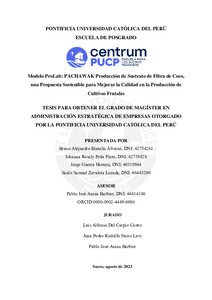| dc.contributor.advisor | Arana Barbier, Pablo José | |
| dc.contributor.author | Bianchi Álvarez, Bruno Alejandro | |
| dc.contributor.author | Peña Pinto, Johanna Rosaly | |
| dc.contributor.author | Guerra Herrera, Jorge | |
| dc.contributor.author | Zavaleta Lozada, Saulo Samuel | |
| dc.date.accessioned | 2023-10-16T21:12:22Z | |
| dc.date.available | 2023-10-16T21:12:22Z | |
| dc.date.created | 2023 | |
| dc.date.issued | 2023-10-16 | |
| dc.identifier.uri | http://hdl.handle.net/20.500.12404/26193 | |
| dc.description.abstract | Existen muchas empresas agrícolas que poseen una alta demanda de fertilizantes para
el abonamiento de la tierra y plantaciones; este alto grado de uso origina impactos negativos
en el ambiente (suelo, aire y agua). Asimismo, existe una dependencia del mercado de
fertilizantes ruso para abastecer a los productores agrícolas a nivel internacional.
Actualmente, este abastecimiento se ve afectado por el contexto geopolítico de los conflictos
bélicos entre Ucrania y Rusia, generando que los costos de los fertilizantes se incrementen, su
producción y abastecimiento a nivel mundial se haya visto afectada. En ese sentido, se ha
propuesto el modelo de negocio Pachawak para la producción sustrato de fibra coco, basado
en la utilización de la cáscara de este que se obtiene como desecho del consumo de la pulpa y
agua de coco. Estos productos serán empleados para sustituir el uso de la tierra, generar
menos uso de agua y menos fertilizantes para las producciones de diferentes cultivos
agrícolas como arándanos, tomates, fresas, frambuesas, etc. De esta manera, se estará
reduciendo la contaminación del ambiente, el uso indiscriminado del agua y fertilizantes, y
contribuyendo directamente con el cambio climático en el mundo.
El Salvador, Tonga y el Perú fueron los países con el mayor rendimiento promedio de
producción de coco, con 29.4, 20.0 y 14.8 toneladas por hectárea, respectivamente, por lo que
superaron en 453.8%, 276.30% y 179.10% el rendimiento promedio mundial, que fue de 5.3
toneladas por hectárea (Olmo, 2021). Por lo tanto, luego de invertir S/ 892,052, este modelo
de negocio originará un valor actual neto de S/ 1’184,166 en cinco años S/ 2’699,265 también
tendrá un impacto en el medio ambiente, incentivando el empleo de alternativas amigables
con el medio y promoviendo la conciencia de los productores de productos agrícolas sobre el
uso consciente de los recursos naturales. | es_ES |
| dc.description.abstract | There are many agricultural companies that have a high demand for fertilizers for the
fertilization of the land and plantations; this high degree of use generate to a negative impact
on the environment (soil, air and water). Likewise, there is a dependency on the Russian
fertilizer market to supply agricultural producers internationally. Currently, this supply is
affected by the geopolitical context of the war between Russia and Ukraine, causing the costs
of fertilizers to increase and their production and supply worldwide to have been affected. In
this sense, the Pachawak business model has been proposed to produce of coconut fiber
substrate, based on the use of its shell, which is obtained as waste from the consumption of
coconut pulp and water. These products will be used to replace land use, generate less water
consumption and less fertilizer to produce different agricultural crops such as blueberries,
tomatoes, strawberries, raspberries, etc. In this way, you will be reducing environmental
pollution, the indiscriminate use of water and fertilizers, and directly contributing to climate
change in the world.
Salvador, Tonga, and Peru were the countries with the highest average coconut
production yield, with 29.4, 20.0, and 14.8 tons per hectare, respectively, thus exceeding the
world average yield by 453.8%, 276.30%, and 179.10%, which it was 5.3 tons per hectare
(Olmo, 2021). Thus, with an investment of 892,052 soles, this business model will generate a
net present value of 1’184,166 soles over a five-year horizon. Likewise, an environmental
impact will be generated 2’699,265 soles promoting the use of environmentally friendly
alternatives and raising awareness among agricultural producers about the responsible use of
natural resources. | es_ES |
| dc.language.iso | spa | es_ES |
| dc.publisher | Pontificia Universidad Católica del Perú | es_ES |
| dc.rights | info:eu-repo/semantics/openAccess | es_ES |
| dc.rights.uri | http://creativecommons.org/licenses/by-nc-nd/2.5/pe/ | * |
| dc.subject | Agricultura--Fertilizantes | es_ES |
| dc.subject | Agricultura--Aspectos ambientales--Perú | es_ES |
| dc.subject | Industrias agrícolas--Perú | es_ES |
| dc.subject | Productos agrícolas | es_ES |
| dc.title | Modelo prolab: Pachawak producción de sustrato de fibra de coco, una propuesta sostenible para mejorar la calidad en la producción de cultivos frutales | es_ES |
| dc.type | info:eu-repo/semantics/masterThesis | es_ES |
| thesis.degree.name | Maestro en Administración Estratégica de Empresas | es_ES |
| thesis.degree.level | Maestría | es_ES |
| thesis.degree.grantor | Pontificia Universidad Católica del Perú. CENTRUM | es_ES |
| thesis.degree.discipline | Administración Estratégica de Empresas | es_ES |
| renati.advisor.dni | 44614140 | |
| renati.advisor.orcid | https://orcid.org/0000-0002-4449-0086 | es_ES |
| renati.author.dni | 42754261 | |
| renati.author.dni | 42738828 | |
| renati.author.dni | 40318964 | |
| renati.author.dni | 46445290 | |
| renati.discipline | 413307 | es_ES |
| renati.juror | Del Carpio Castro, Luis Alfonso | es_ES |
| renati.juror | Narro Lavi, Juan Pedro Rodolfo | es_ES |
| renati.juror | Arana Barbier, Pablo José | es_ES |
| renati.level | https://purl.org/pe-repo/renati/level#maestro | es_ES |
| renati.type | https://purl.org/pe-repo/renati/type#tesis | es_ES |
| dc.publisher.country | PE | es_ES |
| dc.subject.ocde | https://purl.org/pe-repo/ocde/ford#5.02.04 | es_ES |







